The strategic use of AP Inter 1st Year Economics Model Papers and AP Inter 1st Year Economics Question Paper May 2016 allows students to focus on weaker areas for improvement.
AP Inter 1st Year Economics Question Paper May 2016
Note : Read the following instructions carefully :
- Answer ALL the questions as per the choice specified. Draw suitable diagrams wherever necessary.
- Questions from Serial Nos. 1 to 5 in Section ‘A’ are of Long Answer Type. Each question carries TEN marks. ANY THREE questions j may be answered out of five given questions. Every answer may he limited to 40 lines.
- Questions from Serial Nos. 6 to 17 in Section ‘B’ are of Short Answer Type. Each question carries FIVE marks. ANY EIGHT questions may be answered out of twelve given questions. Every answer may be limited to 20 fines.
- Questions from Serial Nos. 18 to 37 in Section ‘C’ are of Very Short Answer Type. Each question carries TWO marks. ANY FIFTEEN questions may be answered out of twenty given questions. Every answer may be limited to 5 fines.
Section – A
Note : Answer ANY THREE out of the following five questions. (3 × 10 = 30)
Question 1.
Explain consumer equilibrium which the help of law of equi marginal utility.
Answer:
Law of equi-marginal utility is an important law of consumption. It is called as “Gossen’s with the name of H.H.Gossen. According to Marshall “If person has a thing which can be put to several uses, he will distribute it among these uses in such a way that it has the same marginal utility in all uses. If it had a greater marginal utility in one use than in another, he would gain by taking away some of it from the second and applying it to the first”.
According to this law the consumer has to distribute his money income on different uses in such a manner that the last rupee spent on each commodity gives him the same marginal util-ity. Equalisation of marginal utility in different uses will maximise his total satisfaction. Hence this law is known as “law of equi-mar-ginal utility”.
Assumptions of the law : The law of equi-marginal utility depends on the following assumptions.
- This law is based on cardinal measurement of utility.
- Consumer is a national man always aiming at maximum satisfaction.
- The marginal utility of money remains constant.
- Consumer’s income is limited and he is proposed to spent the entire amount on different goods.
- The price of goods are unchanged.
- Utility derived from one commodity is independent of the utility of the other commodity.
The fundamental condition for consumer’s equilibrium can be explained in the following way.
\(\frac{\mathrm{MU}_{\mathrm{x}}}{\mathrm{P}_{\mathrm{x}}}=\frac{\mathrm{MU}_{\mathrm{y}}}{\mathrm{P}_{\mathrm{y}}}=\frac{\mathrm{MU}_{\mathrm{z}}}{\mathrm{P}_{\mathrm{z}}}\) = MUm
Where MUx, MUy, MUz, MUm = marginal utility of commodi-ties X, Y, Z, m;
Px Py, Pz = prices of x, y, z.
This law can be explained with the help of a table. Suppose the consumer is prepared to spend his money income is ₹ 26/- on two goods x and y. Market prices of two goods are ₹ 4/- & ₹ 5/- respec-tively. Now the marginal utilities of goods x & y are shown below.
| Units Ux | MUx | Units Uy | MUy |
| 1 | 44 | 1 | 45 |
| 2 | 40 | 2 | 40 |
| 3 | 36 | 3 | 35 |
| 4 | 32 | 4 | 30 |
| 5 | 28 | 5 | 25 |
For. explaining consumer’s maximum satisfaction and conse-quent equilibrum position we need to reconstruct the above table dividing marginal utilities of x its price ₹ 4/- and marginal util- r of y by ₹ 5/-. This is shown in the following table.

In the table it is clear that when consumer purchase 4 units of goods x & 2 units of good y. Therefore, consumer will be in equilibrium when he is spending (4 × 4 = 16 + 2 × 5 = 10)₹ 26 on them. Consumer’s equilibrium may be shown in the diagram.
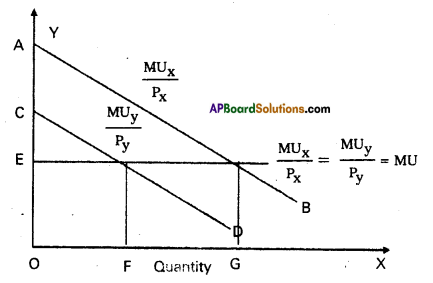
In the diagram marginal utility curves of goods slope down-wards i.e. AB & CD taking the income of the consumer as given, suppose his My of money constant at OE. \(\frac{M U_x}{P_x}\)
is equal to OE
when OG quantity of good X is brought. \(\frac{\mathrm{MU}_{\mathrm{y}}}{\mathrm{P}_{\mathrm{y}}}\) is equal to OE, when OF quantity of good y is purchased. Thus consumer pur-chasing OG of X and OF of Y. \(\frac{\mathrm{MU}_{\mathrm{x}}}{\mathrm{P}_{\mathrm{x}}}=\frac{\mathrm{MU}_{\mathrm{y}}}{\mathrm{P}_{\mathrm{y}}}\) = MUm This is consumer’s equilibrium.
![]()
Question 2.
Explain the law of variable proportions with suitable table and diagram.
Answer:
The law of variable proportions is also known as the Law of diminishing marginal returns. Economists like Ricardo, Malthus, Marshall gave more importance to this law and propounded their theories by keeping this law as basis. The law of variable propor-tions refers to the short-run. According to the classicals and Marshall, this law is applicable to the agricultural sector only. But the modern economists hold that the law is applicable to all the sectors.
The law of variable proportions explains the changes in output when a factor of production is varied while keeping other factors constant in the short period. The law states that if more and more units of variable input is applied to a given quantity of fixed inputs, the total output may initially increases at an increasing rate but beyond a certain level, the rate of increase in the total output diminishes.
According to ‘Marshall’:
“An increase in the amount of labour and capital applied in the cultivation of land causes in general, a less than proportionate increase in the amount of output raised unless it happens to coincide with an improvement in the arts of agriculture”.
According to ‘Benham’:
“As the proportion of one factor in a combination of factors is increased, after a certain point. First the marginal and then the average product of that factor will diminish”.
Assumptions of the law:
- The state of technology remains unchanged.
- Input prices remain unchanged.
- It is possible to vary the proportions in which the various inputs are combined.
- All units of the variable factors are homogeneous.
- It is assumed that the entire operations belongs to short period.
- The product should be measured in physical units.
Explanation of the law:
Let us illustrate the law with the help of table where on the fixed units of land of two acres, units of variable factor are employed keeping other factors constant. The changes in total product, average product and marginal product can be observed in the following schedule.
| Variable factor (labour) | Total product (quintals) | Average product (quintals) | Marginal product (quintals) | Stages |
| 1 | 3 | 3 | 3 | I
Increasing returns to stage |
| 2 | 7 | 3.5 | 4 | |
| 3 | 12 | 4 | 5 | |
| 4 | 16 | 4 | 4 | |
| 5 | 19 | 3.8 | 3 | II
Diminishing returns stage |
| 6 | 21 | 3.5 | 2 | |
| 7 | 22 | 3.1 | 1 | |
| 8 | 22 | 2.8 | 0 | III
Negative returns stage |
| 9 | 21 | 2.3 | -1 | |
| 10 | 19 | 1.9 | -2 |
Total production:
Sum of the marginal productions is called total production. Total product refers to the total output produced per unit of time by all the labours employed.
Average production:
It refers to the product per unit of labour. If total’ product is divided by the number of labourers employed we get average product.
Marginal product: It is the additional product obtained by employing an additional labour.
Marginal product = \(\frac{\Delta \mathrm{TP}}{\Delta \mathrm{L}}\)i.e
\(\frac{Change in total output}{Change in labour}\)
Increasing returns:
In the above table total production increasing at increasing rate upto the 4th labourer then the average and marginal production also increasing. At the 4th labourer the average product (4 units) is equal to the marginal product (4 units). This is the ‘First stage’ which is known as the stage of ‘Increasing returns’.
Diminishing returns:
In this stage total production increasing at diminishing rate and becomes to maximum then the average production and marginal productions are diminishing. In the above table at the 8th labourer total production reaches to maximum (22 units) and marginal production becomes to zero. This is the ‘second stage’ which is known as the stage of diminishing returns.
Negative returns:
In this stage total production diminishing positively, average production also but marginal production becomes negative. This is the third stage which is known as the ‘Stage of Negative Returns’. Let us illustrate the law with the help of a diagram.
In the diagram TP, MP and AP curves inverse, at first reach their maximum and then start declining. The first stage relates to increasing return stage. When more units of labour are applied to a fixed factor, the fixed factor is used more intensively and productivity increases rapidly. This stage is shown in the diagram
from O to C. TP, AP and MP are increasing is noted in this stage. A rational producer will not stop his production in this stage. In the third stage marginal product becomes zero and negative. A rational producer will not undertake production in this stage. This stage starts from point ‘N’. These two stages will not feasable and profitable. Therefore, production will always take place in the second stage but not at the end of the IInd stage because, the MP is equal to zero.
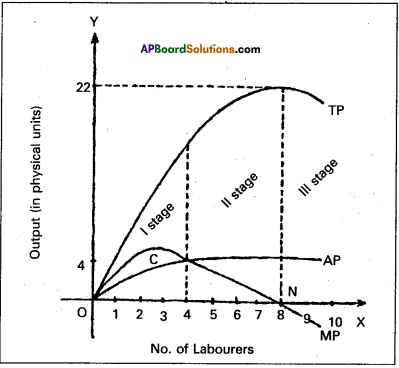
In the I stage MP curve first rises and start falling after reaching maximum. In the II stage AP starts falling. MP and AP are falling but TP is still rising. In the III stage TP, AP and MP are all falling but MP becomes negative.
Importance of the law: This law has several theoretical and practical usages.
- This law is the basis for Malthus population theory of population.
- It is the basis of Ricardian theory of rent.
- It helps to agricultural sector.
- It helps to industrial sector for taking decisions.
Question 3.
Define the perfect competition. Explain its characteristics.
Answer:
Perfect competitive market is one in which the number of buyers and sellers is very large, all engaged in buying and selling a homogeneous products without any restrictions.
The following are the features of perfect competition :
1) Large number of buyers and sellers: Under perfect com-petition the number of buyers and sellers are large. The share of each seller and buyer in total supply or total demand is small. So no buyer and seller cannot influence the price. The price is deter¬mine only demand and supply. Thus the firm is price taker.
2) Homogeneous product: The commodities produced by all the firm of an industry are homogeneous or identical. The cross elasticity of products of sellers is infinite. As a result, single price .will rule in the industry.
3) Free entry and exit: In this competition there is a free¬dom of free entry and exit. If existing firms are getting profits. New firms enter into the market. But when a firm getting losses, it would leave to the market.
4) Perfect mobility of factors of production : Under perfect competition the factors of production are freely mobile between the firms. This is useful for free entry and exits of firms.
5) Absence of transport cost: There are no transport cost. Due to this, price of the commodity will be the same throughout the market.
6) Perfect knowledge of-the e conomy: All the buyers and sellers have full information regarding the prevailing and future prices and availability of the commodity. Information regarding market conditions is availability of commodity.
7) Shape of revenue curves: The shape of revenue curves under perfect competition is parallel to the ‘X’ axis.

Question 4.
Define National Income. Explain various concepts of National Income.
Answer:
National Income means the aggregate value of all the final goods and services produced in the economy in one year.
Concepts of National Income :
1) Gross National Product (GNP): It is the total value of all final goods and services produced in the economy in one year.
The main components of GNP are :
a) The goods and services purchased by consumers – C.
b) Investments made by public and private sectors – I.
c) Government expenditure on public utility services – G.
d) Incomes earned through International Trade (x – m).
e) Net factor incomes from abroad.
GNP at market prices = C + I- G+ (x – m) + Net factor income from abroad.
2) Gross Domestic Product (GDP):
The market value of the total goods and services produced in a country in one particu¬lar period usually in a year is the GDP.
GDP = G + I + G
3) Net National Product(NNP):
Firms use continuously machines and tools for the production of goods and services. This result in a loss of value due to wear and tear of fixed capital. The loss suffered by fixed capital is called depreciation. When we substract depreciation from GNP we get NNP.
NNP = GNP – depreciation.
4) National Income at factor cost:
The cost of production of a good is equal to the rewards paid to the factors which partici-pated in the production process. So the cost of production of a firm is the rent paid land, wages paid labour, interest paid on capi-tal and profits of the entrepreneur.
National Income at factor cost = NNP + Subsidies – Indirect Taxes – Profits of Govt, owned firms.
5) Personal Income:
It is the total of incomes received by all persons from all sources in a specific time period. Personal income is not equal to National Income. Because social security payments. Corporate taxes, undistributed profits are deducted from national income and only the remaining is received by persons.
Personal Income = National Income at factor cost – Undistributed profits – Corporate taxes – Social security contributions + Transfer payments
6) Disposable income:
Personal income totally is not avail-able for spending income tax is a payment which must be deducted to obtain disposable income.
Disposable income = Personal income – Personal taxes D.I = Consumption + Savings
7) Percapita income:
National Income when divided by country’s population. We get percapita income.
Percapita income = \(\frac{\text { Nation Income } \cos t}{\text { Total Population }}\)
The average standard of living of a country is indicated by percapita income.
![]()
Question 5.
Explain the salient features of classical theory of output and imp comment.
Answer:
The theory of output and employment developed by economists such as Adam Smith, David Ricardo, Malthus is known as classical theory. It is based on the famous “Law of markets” advocated by J.B. Say. According to this law “supply creates its own demand”. The classical theory of employment assumes that there is always full employment of labour and other resources. The classical economists ruled out any general unemployment in the long run. These views are known as the classical theory of output and employment.
The classical theory of employment can be three dimensions.
A. Goods market equilibrium
B. Money market equilibrium
C. Equilibrium of the labour market (Pigou wage cut policy)
A) Goods market equilibrium:
The 1st part of Say’s law of markets explains the goods market equilibrium. According to Say “supply creates its own demand”. Say’s law states that supply al-ways equals demand. Whenever additional output is produced in the economy, the factors of production which participate in the process of production. The total income generated is equivalent to the total value of the output produced. Such income creates addi-tional demand for the sale of the additional output. Thus there could be no deficiency in the aggregate demand in the economy for the total output. Here every thing is automatically adjusting without need of government intervention.
The classical economists believe that economy attains equi-librium in the long run at the level of full employment. Any dis-equilibrium between aggregate demand and aggregate supply equi-librium adjusted automatically. This changes in the general price level is known as price flexibility.
B) Money market equilibrium:
The goods market equilibrium leads to bring equilibrium of both money and labour markets. In goods market, it is assumed that total income spent the classical economists agree that part of the income may be saved. But the savings is gradually spent on capital goods. The expenditure on capital goods is tailed investment. It is assumed that equality between savings and investment is brought by the flexible rate of interest. This can be explained by the following diagram.
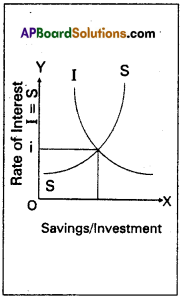
In the diagram savings and Investment are measured on the X’ axis and rate of interest on V axis. Savings and investments are equal at ‘Oi’ rate of interest. So money market equilibrium can be automatically brought through the rate of interest flexibility.
C) Labour market equilibrium:
According to the classical economists, unemployment may occur in the short run. This is not because the demand is not sufficient but due to increase in the wages forced by the trade unions. A.C. Pigou suggests that reduction in the wages will remove unemployment. This is called wage – cut policy. A reduction in the wage rate results in the increase in employment. .
According to the classical theory supply of and demand for labour are determined by real wage rate. Demand for labour is the inverse function of the real wage rate. The supply of labour is the direct function of real wage rate. At a particular point real wage rate the supply of and the demand for labour in the economy be¬come equal and thus equilibrium attained in the labour market. Thus there is full employment of labour. This can be explained with the help of diagram.
In the above diagram supply of and demand for labour is mea¬sured on the X – axis. The real wage rate is measured on the T axis. If the wage rate is OWj, the supply of labour more than the demand for labour. Hence the wage rate falls. If the real wage rate is OW2, the demand for labour is more than supply of labour. Hence the wage rate rises. At OW, real wage rate the supply and demand are equal. This is equilibrium.
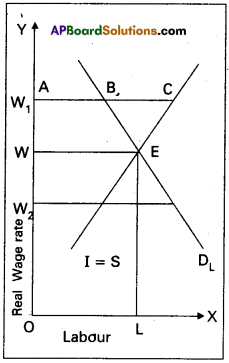
Assumptions :
- There is no interference of government of the economy.
- Perfect competition in commodity and labour market.
- Full employment.
- Wage flexibility.
- Money does not matter.
- Savings and investment depends on the rate of interest.
- Supply of and demand for labour depends on real wage rate.
Section – B
Note : Answer ANY THREE out of the following five twelve question (8 × 5 = 40)
Question 6.
Discuss the differences between Micro Economics and Macro Economics.
Answer:
The difference between Micro Economics and Macro Economics : Micro and Macro Economics are interrelated to each other. Inspite of close relationship between the two branches of economics,, fundamentally they differ from each other.
| Micro Economics | Macro Economics |
| 1. The word micro derived from the greek word’ Mikros’ means “small”. | 1. The word macro derived from the greek word ‘Makros’ which means “large”. |
| 2. Micro Economics is the study of individual units of the economy. | 2. Macro Economics is the study of economy as a whole. |
| 3. It is known as Price theory. Micro Economics explains | 3. It is known as Income and Employment theory. |
| 4. Price determination both commodity and factor markets. | 4. Macro Economics deals with national income, total employ ment, general price level and economic growth. |
| 5. Micro Economics is based on price mechanism which depends on demand and supply. | 5. Macro Economics based on aggregate demand and aggre-gate supply. |
Question 7.
Explain the characteristics of Human wants.
Answer:
Wants are the starting point of all economic activities. As social conditions improve, people prefer not only to satisfy their basic needs but also to have comforts and luxuries. So if one want is satisfied, the other crops up. If there are no wants, there is no consumption, no production, no exchange, no distribution etc.
Characteristic features of human wants : Human wants are not uniform or similar. They differ from person to person, time to time and place to place. Wants are having the following characteristic features.
1) Wants are unlimited:
Human Wants are unlimited. There is no end to human wants. When want is satisfied another want takes its place. A person who has no cycle would like to have it in the first instance, latter scooter, car etc.
2) A particular want is satiable:
Although a man cannot satisfy all his wants, a particular want cam be satisfied completely in a period of time. It is possible because the intensity of wants is limited. Ex : Want for T.V can be satisfied by purchasing a T.V An important law in economics known as the law of Diminishing Marginal Utility is based on this characteristic.
3) Wants are competitive:
Human wants are unlimited. But the means to satisfy them are limited of scarce. Hence it is possible for us to satisfy some wants only and leave the rest. So, every want completes with other to get satisfied.
4) Wants are complementary:
To satisfy a particular want we need a group of commodities at the same time. In other words, satisfaction of a single want requires the simultaneous consumption of a number of commodities. Ex : To satisfy the want for coffee we need milk, sugar, decoction etc.
5) Wants are alternative:
Most of our wants can be satisfied by different ways. For example : we can satisfy our hunger either by taking meal or bread or fruits or milk etc. Thus particular want can be satisfied by several alternatives.
6) Wants are recur:
Many of the human wants are recur. They appear again and again although they satisfied completely in a particular time period. Ex: If we feel hungry, we take some food and satisfy this want. But after some time we shall again feel hungry.
7) Wants differ in urgency:
All our wants are not equally important or urgent. They differ greatly in intensity. Some wants are more urgent and other are less urgent.
![]()
Question 8.
Write the properties of Indifference curves.
Answer:
Indifference curve shows the various combinations of two commodities which yield equal utility or satisfaction to the con-sumer.
Indifference schedule:
According to A.L. Meyers “An indifference schedule may be defined as schedule of various combinations of goods that will be equally satisfactory to the individual concerned”. This can be explained with the help of a table and diagram.
| Combinations | Number of x | Number of y |
| A | 1 | 20 |
| B | 2 | 15 |
| C | 3 | 11 |
| D | 4 | 8 |
| E | 5 | 6 |
| F | 6 | 5 |
In the above schedule the consumer gets as much total satisfaction from combination A and as well as from other combinations B, C, D, E and F, the total satisfaction is seeme in all these combinations. Since consumer get same satisfaction he is indifferent to select any one of the combinations. Therefore this may be called “weak ordering”.
Indifference curve:
With the help of the above table we can draw an indifferent curve to study its properties. In the side diagram ‘X’ good are shown on ‘OX’ axis ; and ‘Y’ good shown on ‘OY’ axis.
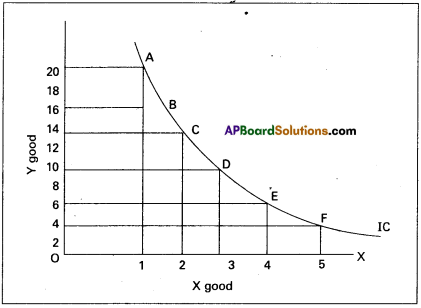
IC is the indifferent curve. A, B, C, D, E, and, F are the various combinations of X and Y. The points on indifference curves give the consumer the equal level of satisfaction of various points is the same that isA = B = C = D = E = E
Properties of indifference curves: The important properties of Indifference curve are
- Indifference curves slopes downwards from left to right there exists negative slope.
- Higher indifference curve represent higher levels of satisfaction. Indifference curve to the right represents high satisfaction.
- The indifference curves can never meet or intersect each other.
- The indifference curves are convex to the origin.
- Indifference curves need not be parallel to each other.
Question 9.
Why the demand curve slopes downwards from left to right?
Answer:
According to Marshall “The amount demanded increases with a The law of demand explains inverse relationship between the price and quantity demanded of a commodity. Therefore the demand curve slopes downward from left to right.

There are some other reasons also responsible for downward sloping demand curve. They are :
1) Old and new buyers:
If the price of good falls, the real income of the old buyers will increase. Hence the demand for the good will increase. In the same way, the fall in price attracts new buyers and will be able to built after a Ml in its price. So the demand curve slopes downwards from left to right.
2) Income effect:
Fall in price of commodity the real income of its consumers increase. The increase in real income encourages demand for the commodity with reduced price. The increase in demand on account of increased in real income is known as income effect.
3) Substitution effect:
When the price of commodity falls, it will become relatively cheaper than its substitutes. The increase in demand on account of increased in real income is known as income effect.
4) Law of Diminishing marginal utility:
According to this law, if consumer goes on consuming more units of the commodity, the additional utility goes an diminishing. Therefore, the consumer prefers to buy at a lower price. As a result the demand curve has a negative slope.
Question 10.
Explain total expenditure method to measure the elasticity of demand.
Answer:
Refer Q.No. 1 in Model Paper-1.
Question 11.
Explain the concepts of scarcity Rent and Quasi rent.
Answer:
Rent is a remuneration paid to the land lord for using the services of land. Scarcity Rent: Marshall explained the concept of scarcity of rent on the basis of demand and supply. In general land has indirect demand or derived demand. If there is an explosion of population demand for land increases this result rise in its price. The surplus earned by land above its price is called scarcity rent.- The supply df land is fixed and inelastic. The demand for land will determine the rent by influencing it’s price. Hence rent arises due to the scarcity in the supply of factors of production.
In the side diagram on ’OX’ axis represent supply and demand for land. ‘OY’ axis represents Rent. SL is supply of land. It is perfectly inelastic when ‘DD’ curve shifts upward to D1 D1. So price increases from OR to OR1 Similarly if demand curve further shifts from D1 D1 to D2D2 rent price further increases from OR1 to OR2 .
Quasi Rent:
The concept of Quasi Rent was first introduced by Marshall. According to Marshall, Quasi Rent is the income derived from machines and other man made appliances of production. Whose supply is inelastic in the short run in relation to their demand. If the demand for these factors increases, their prices will also increase due to their inelasticity of supply in the short period. The rent or surplus above the factor price will disappear in the long run
In the above diagram man made appliances are shown in ‘OX’ axis and ‘OY’ axis shown rent. SPS in short period supply curve. LPS is long period supply curve. In the above diagram it is observed that rent will disappear in the long run
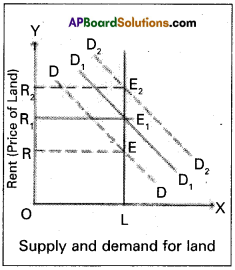
Question 12.
Describe factors determining th National Income.
Answer:
National Income is the total market value of all goods and services produced in a country during a given period of time. There are many factors that influence and determine the size of national income country.
a) Natural resources:
The availability of natural resources in a country, its climatic conditions, geographical features, fertility of soil, mines and fuel resources etc., influence the size of national income.
b) Quality and Quantity of factors of production:
The national income of a country is largely influenced by the quality and quantity of a country’s stock of factors of production.
c) State of technology:
Output and national income are in-fluenced by the level of technical progress achieved by the coun-try. Advanced techniques of production help in optimum utiliza-tion of a country’s national resources.
d) Political will and stability:
Political will and stability in a country helps in planned economic development and for a faster growth of national income.
![]()
Question 13.
Write the items include in public expenditure.
Answer:
Public expenditure is an important constituent of public finance. Modem governments spend money from various welfare activities. The expenditure incurred by the government on various economic activities is called public expenditure. Governments incur expenditure on the following heads of accounts.
- Defence
- Internal security
- Economic services
- Social services
- Other general services
- Pensions
- Subsidies
- Grants to state governments
- Grants to foreign governments
- Loans to state governments
- Loans to public enterprises
- Loans to foreign governments
- Repayment of loans
- Assistance to states on natural calamities etc.
Question 14.
Explain the concept of Effective demand.
Answer:
Effective demand means where aggregate demand equals the aggregate supply. When aggregate demand is equal to aggregate supply the economy is in equilibrium. This can be shown in the table
| Level of employment | Aggregate supply price | Aggregate demand price |
| 10 | 500 | 600 |
| 11 | 550 | 625 |
| 12 | 600 | 650 |
| 13 | 650 | 675 |
| 14 | 700 | 700 AD = AS |
| 15 | 750 | 725 |
| 16 | 800 | 750 |
In the above table when the level of employment is 14 lakh workers, aggregate demand price is equal to aggregate supply price i.e ₹ 700 crores. This can be shown in the following diagram.

In the above diagram aggregate .demand price curve (AD) and the aggregate. Supply price curve (AS) interest each other at ‘ point Er It shows the equilibrium point. The equilibrium has been attained at ON1 level of employment. It is assumed that ON1 in the above diagram does not indicate full employment as the economy is having idle factors of production. So it is considered as under-employment equilibrium.
According to Keynes, to achieve full employment an upward shift of aggregate demand curve is required. This can be possible through government expenditure on goods and services supplied in the economy, whenever private entrepreneurs may not show interest to invest. With this the AD1 curve (C + I) shift as AD2 (C + I + G) at new point of effective demand E2, where the economy reaches full employment level i.e., ONF.
Question 15.
Define Inflation. Explain the types of Inflation.
Answer:
Inflation means a general rise in prices. Based on the rate of inflation, it may be divided into four types.
- Creeping inflation : When rise in the prices is very slow and small, it is called creeping inflation.
- Walking inflation : This is” the second stage of inflation. The inflation rate will be between 2% and 4%.
- Running inflation : When the rate of inflation is in the range of 4 -10% per annum, it is called running inflation.
- Galloping inflation or hyper inflation : If the inflation rate exceeds 10%, galloping inflation occurs. It may also called hyper inflation.
Question 16.
Explain various depsoits given by Commerical Banks.
Answer:
The commercial Banks accept different deposits from the public. They are as follows.
a) Accepting deposits :
The commercial bank just like any other money lender is doing money lending business bank receives public money in the form of deposits. The deposits mainly are of the following steps.
1) Current deposits:
These deposits have two character-istics. One, there are no restrictions with regard to the amount of withdrawl and number of withdrawls. Banks normally do not pay any interest on current account deposits.
2) Savings deposits:
The sole aim of banks in receiving these deposits is to promote the habit of thrift among low income groups. They have the following characteristics:
1) two or three withdrawls per week are permited
2) banks pay 4 to 5% interest (nominal) per annum or savings deposits.
3) Recurring deposits:
People will deposit their money in these deposits as monthly installments for a fixed period of time. The bank after expiry of the said period will return the total amount with interest thereon. The rate of interest will be higher than the savings deposits.
4) Fixed deposits: Deposits received on fixed accounts are called fixed or time deposits. They are left with the bank for a fixed period. The following are the characteristics.
i) The amount cannot be withdrawn before the expiry of the fixed period.
ii) Banks pay high rate of interest than any other deposits.
Question 17.
Findout Mode to the given data

Answer:
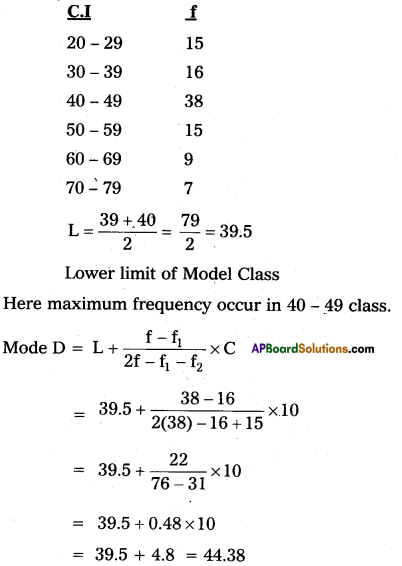
Section – C
Note : Answer ANY EIGHT out of the following twelve question (15 × 2 = 30)
Question 18.
Intermediary goods.
Answer:
Goods which are under the process of production and semi finished goods are known as intermediary goods. They occupy a stage between raw material and final product. Ex : cotton and fibre etc.
Question 19.
Wealth.
Answer:
Wealth means stock of assets held by an individual or institution that yields has the potential for yielding income in some form. Wealth includes money, shares of companies, land etc. Wealth has three properties.
- Utility
- Scarcity
- Transferablity.
Question 20.
Price line/Budget line.
Answer:
The budget line or price line shows all possible combinations of two goods that a consumer can buy with the given income of the consumers and prices of the two goods.
Question 21.
Demand function.
Answer:
It shows functional relationship between quantity demanded at various factors that determine the demand for a commodity. It can be expressed as follows.
Dx = f[Px,P1……Pn,Y,T]
Where
Dx = Demand for good x
Px = Price of x
P1 …. Pn = Prices of substitutes and complementary
Y = Income of consumer
T = Tastes
f = Functional relationship
Question 22.
Giffen paradox
Answer:
It means necessary goods. Sir Robert Giffen in mid 19th century observed that the low paid workers in England purchased more bread when its price increase by decrease in the purchase of » meat. The increase in demand for bread when price increased is an exception to the law of demand, it is known as Giffen’s pardox.
Question 23.
Marginal cost.
Answer:
Marginal cost is the additional cost of production producing one more unit in other words it is the addition made to total cost by producing one more unit of a commodity.
Question 24.
Oligopoly.
Answer:
A market with a small number of producer is called oligopoly. The product may be homogeneous or may be differences. This market exists in automobiles, electricals etc.
![]()
Question 25.
Selling costs.
Answer:
An important feature of monopolistic market is every firm makes expenditure to sell more output. Advertisements through newspapers, journals, electronic media etc. these methods are used to attract more consumers by each firm. This type of expenditure is called selling cost.
Question 26.
Economic Rent.
Answer:
The ordinary use of the term’rent’means any periodic payment for the hire of anything such as garriages, buildings etc. Economic rent is the pure rent payable as a reward for utilising the productivity of land. It is derived by subtracting the elements like interest, wages, profits and depreciation from the gross rent or contract rent. To David Ricardo, if is surplus over costs or expenses of cultivation.
Question 27.
Net profit.
Answer:
Net profit is the economic profit of pure business profit. Net profit is the residue obtained by deduction explicit and implicit cost from the total revenue of a firm.
Question 28.
Depreciation.
Answer:
Firms use continuously machines and tools for the production of goods and services. This results in a loss of value due to wear and tear of fixed capital. This loss suffered by fixed capital is called depreciation.
Question 29.
Full employment.
Answer:
Full employment is a situation in which all those who are willing and able to work at the existing market wage rate are engaged in work.
Question 30.
Lonizzez faire.
Answer:
According to classicals the role of government in economic activities should be nominal or very less. The free play of eco¬nomic forces it self bring about the fuller utilization of economic resources including labour. Any interference with the free play of market forces under such circumstances the state shall not inter¬fere in economic matter. It should pursue a policy of Laissezfaire policy of non-intervention in economic matters.
Question 31.
Near money.
Answer:
The near money refers to those highly liquid assets which are not accepted as money but then can be easily converted into money within a short period. Ex : Saving bank deposit, shares, treasury bills, bonds etc.
Question 32.
Over draft.
Answer:
Overdraft is permissable on current account only. The current account holders are given the facility overdrafts by which they are allowed to draw an amount above their balances. However they can overdraw the amount upto a certain limit fixed by the bank.
Question 33.
Liquidity.
Answer:
Liquidity means the ease with which one can convert a financial asset into a medium of exchange. Liquidity is greatest for money as an asset because money itself is a medium of exchange. Infact money is the only asset which possess perfect liquidity.
![]()
Question 34.
Credit creation.
Answer:
It means the process of creating credit from the depositor received bythe bank fromthe customers to those who is in need of many in the form of loans and advances.
Question 35.
Findout AM of 30, 20, 32, 16, 27
Answer:

Question 36.
What is pie diagram?
Answer:
It is also called pie chart. The circle is divided into many parts as there are components by drawing straight lines from the centre of circumference.
Question 37.
What is Bar diagram?
Answer:
Bars are simply vertical lines, where the lengths of bars are proportional to their corresponding numerical values.